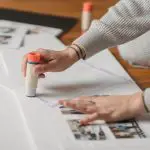Are you looking to repair a tear in your favorite fabric item or add some embellishments to a piece of clothing? Hot glue may seem like an easy and convenient solution, but you may be wondering if it will actually work on fabric. The answer is yes, hot glue can be used on fabric, but there are certain factors to consider and precautions to take to ensure a successful and long-lasting result.
First, it’s important to understand how hot glue works as an adhesive. Hot glue is a thermoplastic adhesive that is melted and applied in a liquid form. As it cools and solidifies, it creates a strong bond between two surfaces. However, not all hot glues are created equal, and some may not be suitable for use on fabric.
In this article, we’ll explore the factors to consider when using hot glue on fabric, how to test it, and tips for using it effectively.
Table of Contents
Understanding Hot Glue as an Adhesive
You might think that hot glue is just a quick and easy way to stick things together, but it’s actually a versatile adhesive that can be used on a variety of surfaces, including fabric.
Hot glue, also known as hot melt adhesive, is made of thermoplastic polymers that are melted and then solidify as they cool. This creates a strong bond that can withstand a lot of stress and strain.
When it comes to using hot glue on fabric, there are a few things to keep in mind. First, you want to make sure that the fabric is clean and free of any dust or debris. This will help the glue adhere better and create a stronger bond. You can use a lint roller or a damp cloth to clean the fabric before applying the glue.
Second, you want to be careful not to use too much glue, as it can seep through the fabric and create a mess. It’s best to apply small dots of glue to the fabric, and then press the two surfaces together firmly. You can also use a toothpick or a small brush to apply the glue more precisely.
With these tips in mind, you should be able to use hot glue successfully on fabric for a variety of projects.
Factors to Consider When Using Hot Glue on Fabric
When using hot glue on fabric, there are three important factors to consider:
- The type of fabric you’re working with
- The temperature of the glue
- The amount of pressure applied
Not all fabrics are created equal, and some may not be able to handle the heat of hot glue. You also want to make sure the glue is at the right temperature and that you’re applying enough pressure to ensure a strong bond.
Type of Fabric
If you’re using hot glue on fabric, be sure to choose a sturdy material that won’t easily tear or fray under the heat and pressure. Some fabrics, such as denim or canvas, are more durable and can handle the adhesive better than delicate fabrics like silk or chiffon.
It’s important to consider the weight and texture of the fabric, as well as the intended use of the finished product, when selecting which type of fabric to use with hot glue. Another factor to consider is the weave of the fabric. Fabrics with a tight weave, such as twill or gabardine, will generally hold up better with hot glue than looser weaves like gauze or lace.
Additionally, if the fabric has a special finish or coating, such as water-resistant or flame-retardant, it may not be compatible with hot glue. Always test a small, inconspicuous area before applying hot glue to the entire fabric surface to ensure compatibility and avoid any damage.
Temperature of the Glue
The temperature of your adhesive can greatly affect its bonding strength and overall effectiveness when working on fabric. Here are some things to keep in mind when using hot glue:
-
Hot glue needs to be at the right temperature to bond well. If it’s too cool, it won’t stick well, and if it’s too hot, it can burn the fabric or even melt it.
-
You want the glue to be warm enough to melt into the fabric fibers and create a strong bond. Most hot glue guns have temperature settings that you can adjust to make sure you’re using the right temperature for your fabric.
-
Keep in mind that different fabrics may require different temperatures. For example, delicate fabrics like silk may require a lower temperature than sturdier fabrics like denim.
-
It’s always a good idea to test the temperature of your glue on a scrap piece of fabric before using it on your project. This will help you avoid any mishaps and ensure that your project turns out just right.
By taking the time to adjust the temperature of your hot glue gun and testing it on a scrap piece of fabric first, you can ensure that your adhesive will bond well and your project will be a success.
Amount of Pressure Applied
You can enhance the strength of your bond by applying firm and consistent pressure while attaching the materials together. This is especially important when working with fabric, as it can be more delicate than other materials.
When using hot glue on fabric, it’s essential to make sure that the bond is strong enough to hold up to wear and tear. Applying pressure while the glue is still hot can help to ensure that the bond is secure.
It’s important to note that you don’t want to apply too much pressure, as this can cause the glue to seep through the fabric and create unsightly bumps or marks. Instead, apply enough pressure to create a strong bond, but not so much that you damage the fabric.
With a little practice, you can learn the perfect amount of pressure to apply to create a secure bond that will last for years to come.
Testing Hot Glue on Fabric
So you want to test out using hot glue on fabric? Good call!
To conduct a test, simply apply a small amount of hot glue to a scrap piece of fabric and let it dry completely. Then, try pulling the fabric apart to see if the bond is strong enough for your project.
Remember to interpret the results carefully, as some fabrics may not work well with hot glue even if the bond seems strong.
How to Conduct a Test
To effectively determine if hot glue works on fabric, it’s important to conduct a thorough and controlled test.
First, choose two types of fabric that differ in texture and thickness. Cut a small piece of each fabric and place them side by side.
Then, apply a small amount of hot glue to one fabric and press the other fabric onto it. Hold the fabrics together for about 30 seconds to allow the glue to cool and dry.
After the glue has dried, try to separate the fabrics. If the glue holds the fabrics together firmly and there is no visible damage, then hot glue works on that type of fabric. However, if the glue does not hold the fabrics together or if the fabric is damaged, then hot glue is not suitable for that type of fabric.
Repeat the test with different types of fabrics to determine which ones work best with hot glue.
Interpreting the Results
Now that the test has been conducted and the fabrics have been evaluated, it’s time to understand the implications of the results.
It’s important to note that if the hot glue didn’t work on the fabric, it doesn’t mean that it won’t work on any type of fabric. The type of fabric used in the test may not have been compatible with the hot glue. It’s essential to conduct further tests with different types of fabric to determine if hot glue is suitable for the specific fabric.
If the hot glue did work on the fabric, it’s important to consider the durability of the bond. It may be necessary to conduct further tests to determine how long the bond will last and if it can withstand washing, stretching, and general wear and tear.
Understanding the implications of the test results will help determine if hot glue is a suitable adhesive for the specific fabric and if it will meet the desired outcome.
How to Use Hot Glue on Fabric
Using hot glue on fabric can be a game-changer for your DIY projects, making them more durable and long-lasting. However, it may not be as straightforward as it seems. Here are some tips to help you use hot glue on fabric effectively:
- Prepare your fabric: Before applying hot glue to your fabric, make sure it’s clean and free of any dirt or debris. This will ensure that the glue will adhere properly.
- If you’re working with delicate fabric, such as silk or lace, it’s recommended to test a small area first to ensure the hot glue won’t damage it.
- You can also use a fabric stabilizer or interfacing to reinforce the fabric and prevent it from stretching or fraying.
To apply the hot glue:
- Use a low-temperature hot glue gun to prevent the glue from melting the fabric.
- Apply the hot glue in small sections, working quickly to prevent it from drying before you can attach the fabric.
- Use a toothpick or small brush to spread the glue evenly over the fabric.
By following these tips, you can use hot glue on fabric effectively and create long-lasting DIY projects. Remember to always work carefully and test a small area first before applying hot glue to the entire fabric. Happy crafting!
Tips for Using Hot Glue on Fabric
Get your fabric ready by making sure it’s clean and free of any debris before applying the hot adhesive. This will ensure that the glue adheres properly and doesn’t come off easily. You can use a lint roller or a damp cloth to clean the fabric. Once the fabric is clean, you can start applying the hot glue.
When using hot glue on fabric, it’s important to use the right temperature setting on your glue gun. If the temperature is too high, it can melt the fabric and cause damage. On the other hand, if the temperature is too low, the glue won’t stick properly. Check the instructions on your glue gun to find the right temperature setting for your fabric.
Another tip for using hot glue on fabric is to apply the glue in small sections. This will prevent the glue from drying too quickly and give you more control over the placement of the glue. You can also use a toothpick or a small brush to spread the glue evenly. Once you’ve applied the glue, press the fabric together firmly to ensure a strong bond.
| Pros | Cons |
|---|---|
| Dries quickly | Can be messy |
| Strong bond | Can be difficult to remove |
| Easy to use | Can be visible on light-colored fabrics |
Overall, hot glue can be a great option for attaching fabric together. By following these tips, you can ensure that your hot glue application is successful and your fabric stays in place.
Alternatives to Hot Glue for Fabric Repairs
If you’re looking for alternatives to hot glue for fabric repairs, there are a few options to consider. Fabric glue is a popular choice, as it can easily bond fabric together without the need for sewing.
Fusible webbing is another option, which involves using an iron to melt a thin layer of adhesive onto the fabric.
And of course, good old-fashioned stitching is always a reliable way to repair fabric.
Fabric Glue
Interestingly enough, fabric glue is a great alternative to hot glue when working with fabric. Unlike hot glue, it can often leave a stiff and visible residue on fabric. Fabric glue, on the other hand, dries clear and remains flexible, making it ideal for use on delicate fabrics or items that require a bit of movement.
When using fabric glue, it’s important to follow the instructions carefully. Most fabric glues require a bit of time to dry, so be sure to give it plenty of time to set before handling or washing the item. Additionally, some fabric glues may not hold up well to repeated washings. Therefore, it’s important to choose a high-quality product and test it on a small, inconspicuous area before using it on a larger scale.
Overall, fabric glue is a great choice for those who want a strong, flexible bond without the potential mess and stiffness of hot glue.
Fusible Webbing
Fusible webbing is like a thin sheet of glue that can be ironed onto fabric to bond it to another piece, creating a seamless and professional-looking finish. It’s a great alternative to traditional sewing methods, especially if you don’t have access to a sewing machine or if you’re working with delicate fabrics that could easily be damaged by stitching.
Here are some benefits of using fusible webbing on your fabric projects:
- It’s easy to use and requires minimal skill or experience.
- It creates a strong bond that’ll hold up well over time, even with regular washing and wear.
- It can be used on a variety of fabrics, including cotton, silk, wool, and synthetic blends.
Stitching
Now that you know about fusible webbing, let’s talk about another way to secure fabric together: stitching. Stitching is a traditional method of creating a strong and durable bond between fabric pieces. It involves using a needle and thread to sew the fabrics together. This technique is particularly useful for creating intricate designs or patterns on fabric, as well as for repairing tears or holes in clothing.
To help you decide whether stitching is the right choice for your fabric project, take a look at the table below. It compares the benefits and drawbacks of stitching with those of using hot glue. Keep in mind that while hot glue is a quick and easy option, it may not provide the same level of strength and permanence as stitching. Ultimately, the decision of which method to use will depend on your specific needs and preferences.
| Stitching | Hot Glue |
|---|---|
| Provides a strong and durable bond | May not hold up as well over time |
| Can create intricate designs and patterns | May be messy or difficult to clean up |
| Can repair tears or holes in clothing | May not provide as much precision or control |
| Requires a needle and thread | Requires a hot glue gun and glue sticks |
| May take longer to complete | Can be quicker and easier to use |
- Tetron Fabric for Marine Applications: Durability and Use Cases - June 18, 2025
- Tetron Fabric for Outdoor Furniture: Weather Resistance and Care - June 18, 2025
- Tetron Fabric for Wall Coverings: Style and Application Tips - June 18, 2025






